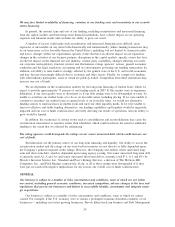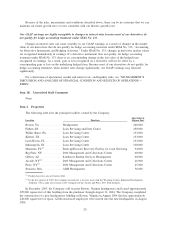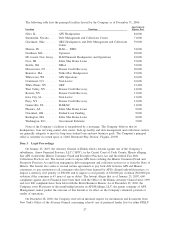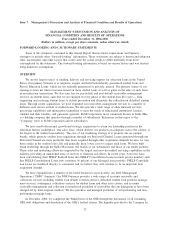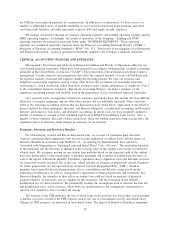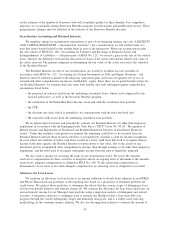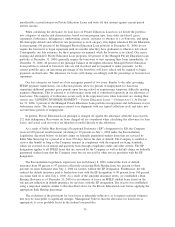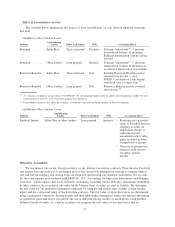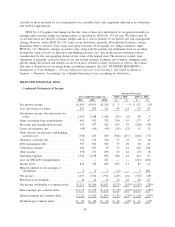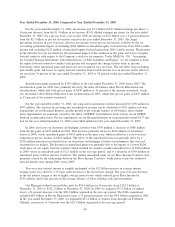Sallie Mae 2006 Annual Report Download - page 35
Download and view the complete annual report
Please find page 35 of the 2006 Sallie Mae annual report below. You can navigate through the pages in the report by either clicking on the pages listed below, or by using the keyword search tool below to find specific information within the annual report.on the estimate of the number of borrowers who will eventually qualify for these benefits. For competitive
purposes, we occasionally change Borrower Benefits programs in both amount and qualification factors. These
programmatic changes must be reflected in the estimate of the Borrower Benefits discount.
Securitization Accounting and Retained Interests
We regularly engage in securitization transactions as part of our financing strategy (see also “LIQUIDITY
AND CAPITAL RESOURCES — Securitization Activities”). In a securitization, we sell student loans to a
trust that issues bonds backed by the student loans as part of the transaction. When our securitizations meet
the sale criteria of SFAS No. 140, “Accounting for Transfers and Servicing of Financial Assets and
Extinguishments of Liabilities — a Replacement of SFAS No. 125,” we record a gain on the sale of the student
loans, which is the difference between the allocated cost basis of the assets sold and the relative fair value of
the assets received. The primary judgment in determining the fair value of the assets received is the valuation
of the Residual Interest.
The Residual Interests in each of our securitizations are treated as available-for-sale securities in
accordance with SFAS No. 115, “Accounting for Certain Investments in Debt and Equity Securities,” and
therefore must be marked-to-market with temporary unrealized gains and losses recognized, net of tax, in
accumulated other comprehensive income in stockholders’ equity. Since there are no quoted market prices for
our Residual Interests, we estimate their fair value both initially and each subsequent quarter using the key
assumptions listed below:
• the projected net interest yield from the underlying securitized loans, which can be impacted by the
forward yield curve, as well as the Borrower Benefits program;
• the calculation of the Embedded Floor Income associated with the securitized loan portfolio;
• the CPR;
• the discount rate used, which is intended to be commensurate with the risks involved; and
• the expected credit losses from the underlying securitized loan portfolio.
We recognize interest income and periodically evaluate our Residual Interests for other than temporary
impairment in accordance with the Emerging Issues Task Force (“EITF”) Issue No. 99-20, “Recognition of
Interest Income and Impairment on Purchased and Residual Beneficial Interests in Securitized Financial
Assets.” Under this standard, each quarter we estimate the remaining cash flows to be received from our
Retained Interests and use these revised cash flows to prospectively calculate a yield for income recognition.
In cases where our estimate of future cash flows results in a lower yield from that used to recognize interest
income in the prior quarter, the Residual Interest is written down to fair value, first to the extent of any
unrealized gain in accumulated other comprehensive income, then through earnings as an other than temporary
impairment, and the yield used to recognize subsequent income from the trust is negatively impacted.
We also receive income for servicing the loans in our securitization trusts. We assess the amounts
received as compensation for these activities at inception and on an ongoing basis to determine if the amounts
received are adequate compensation as defined in SFAS No. 140. To the extent such compensation is
determined to be no more or less than adequate compensation, no servicing asset or obligation is recorded.
Allowance for Loan Losses
We maintain an allowance for loan losses at an amount sufficient to absorb losses inherent in our FFELP
and Private Education Loan portfolios at the reporting date based on a projection of estimated probable net
credit losses. We analyze those portfolios to determine the effects that the various stages of delinquency have
on borrower default behavior and ultimate charge-off. We estimate the allowance for loan losses and losses on
accrued interest income for our Managed loan portfolio using a migration analysis of delinquent and current
accounts. A migration analysis is a technique used to estimate the likelihood that a loan receivable may
progress through the various delinquency stages and ultimately charge-off, and is a widely used reserving
methodology in the consumer finance industry. We also use the migration analysis to estimate the amount of
34


